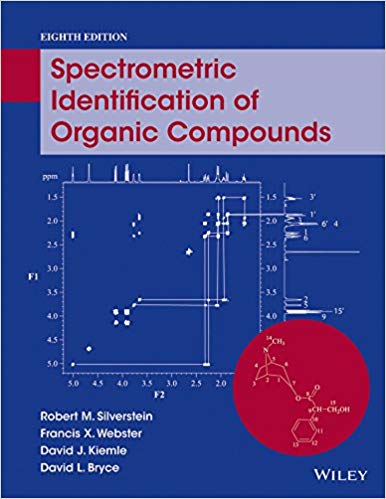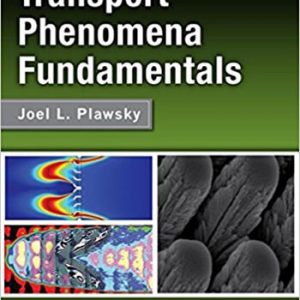Instant download Solution Manual for Spectrometric Identification of Organic Compounds 8th by Silverstein pdf docx epub after payment.

Product details:
- ISBN-10 : 0470616377
- ISBN-13 : 978-0470616376
- Author: Robert M. Silverstein; Francis X. Webster; David J. Kiemle
First published over 40 years ago, this was the first text on the identification of organic compounds using spectroscopy. This text presents a unified approach to the structure determination of organic compounds based largely on mass spectrometry, infrared (IR) spectroscopy, as well as multinuclear and multidimensional nuclear magnetic resonance (NMR) spectroscopy. The key strength of this text is the extensive set of practice and real-data problems (in Chapters 7 and 8). Even professional chemists use these spectra as reference data. Spectrometric Identification of Organic Compounds is written by and for organic chemists, and emphasizes the synergistic effect resulting from the interplay of spectra. This text is characterized by its problem-solving approach with numerous practice problems and extensive reference charts and tables.
Table of contents:
CHAPTER 1 MASS SPECTROMETRY 1
1.1 Introduction 1
1.2 Instrumentation 2
1.3 Ionization Methods 3
1.4 Mass Analyzers 8
1.5 Interpretation of EI Mass Spectra 12
1.6 Mass Spectra of Some Chemical Classes 18
References 37
Student Exercises 37
Appendices 46
A Formula Masses (FM) for Various Combinations of Carbon, Hydrogen, Nitrogen, and Oxygen 46
B Common Fragment Ions 67
C Common Fragments Lost 69
CHAPTER 2 INFRARED SPECTROSCOPY 71
2.1 Introduction 71
2.2 Theory 71
2.3 Instrumentation 76
2.4 Sample Handling 77
2.5 Interpretation of Spectra 78
2.6 Characteristic Group Absorptions of Organic Molecules 81
References 108
Student Exercises 108
Appendices 118
A Transparent Regions of Solvents and Mulling Oils 118
B Characteristic Group Absorptions 119
C Absorptions for Alkenes 124
D Absorptions for Phosphorus Compounds 125
E Absorptions for Heteroaromatics 125
CHAPTER 3 PROTON (1H) MAGNETIC RESONANCE SPECTROSCOPY 126
3.1 Introduction 126
3.2 Theory 126
3.3 Instrumentation and Sample Handling 129
3.4 Chemical Shift 132
3.5 Spin-Spin Coupling, Multiplets, and Spin Systems 137
3.6 Protons on Oxygen, Nitrogen, and Sulfur Atoms:Exchangeable Protons 144
3.7 Coupling of Protons to Other Important Nuclei (19F, D (2H), 31P, 29Si, and 13C) 149
3.8 Chemical Equivalence 150
3.9 Magnetic Equivalence 154
3.10 AMX, ABX, and ABC Rigid Systems with Three Coupling Constants 155
3.11 Weakly and Strongly Coupled Systems: Virtual Coupling 156
3.12 Chirality 158
3.13 Magnitude of Vicinal and Geminal Coupling Constants 160
3.14 Long-Range Coupling 162
3.15 Selective Spin Decoupling: Double Resonance 162
3.16 Nuclear Overhauser Effect 162
3.17 Conclusion 163
References 164
Student Exercises 164
Appendices 175
A Chart A.1: Chemical Shifts of Protons on a Carbon Atom Adjacent (? Position) to a Functional Group in Aliphatic Compounds (M–Y) 175
Chart A.2: Chemical Shifts of Protons on a Carbon Atom Once Removed (? Position) from a Functional Group in Aliphatic Compounds (M–C–Y) 177
B Effect on Chemical Shifts by Two or Three Directly Attached Functional Groups 178
C Chemical Shifts in Alicyclic and Heterocyclic Rings 180
D Chemical Shifts in Unsaturated and Aromatic Systems 181
Chart D.1: Chemical Shifts of Protons on Monosubstituted Benzene Rings 183
E Protons Subject to Hydrogen-Bonding Effects (Protons on Heteroatoms) 184
F Proton Spin-Spin Coupling Constants 185
G Chemical Shifts and Multiplicities of Residual Protons in Commercially Available Deuterated Solvents 187
H Chemical Shifts of Common Laboratory Solvents as Trace Impurities 188
I Proton NMR Chemical Shifts of Amino Acids in D2O 190
CHAPTER 4 CARBON-13 NMR SPECTROSCOPY 191
4.1 Introduction 191
4.2 Theory 191
4.3 Interpretation of a Simple 13C NMR Spectrum: Diethyl Phthalate 198
4.4 Quantitative 13C Analysis 198
4.5 Chemical Equivalence 200
4.6 DEPT 200
4.7 Chemical Classes and Chemical Shifts 203
4.7.1 Alkanes 204
4.7.1.1 Linear and Branched Alkanes 204
4.7.1.2 Effect of Substituents on Alkanes 205
4.7.1.3 Cycloalkanes and Saturated Heterocyclics 205
4.7.2 Alkenes 206
4.7.3 Alkynes 208
4.7.4 Aromatic Compounds 208
4.7.5 Heteroaromatic Compounds 209
4.7.6 Alcohols 209
4.7.7 Ethers, Acetals, and Epoxides 209
4.7.8 Halides 211
4.7.9 Amines 211
4.7.10 Thiols, Sulfides, and Disulfides 211
4.7.11 Functional Groups Containing Carbon 211
4.7.11.1 Ketones and Aldehydes 212
4.7.11.2 Carboxylic Acids, Esters, Chlorides, Anhydrides, Amides, and Nitriles 214
4.7.11.3 Oximes 214
References 214
Student Exercises 214
Appendices 225
A The 13C Chemical Shifts, Coupling Constants, and Peak Multiplicities of Common Deuterated NMR Solvents 225
B 13C Chemical Shifts of Common Laboratory Solvents as Trace Impurities in Selected Deuterated NMR Solvents 226
C 13C Chemical Shift Ranges for Chemical Classes 227
D 13C Chemical Shifts (ppm) for Several Natural Products 229
CHAPTER 5 TWO-DIMENSIONAL NMR SPECTROSCOPY 230
5.1 Introduction 230
5.2 Theory 231
5.3 Correlation Spectroscopy 233
5.3.1 1H-1H Correlation: COSY 235
5.4 Ipsenol: 1H-1H COSY 235
5.4.1 Ipsenol: Double Quantum Filtered 1H-1H COSY 238
5.4.2 Carbon Detected 13C-1H COSY: HETCOR 238
5.4.3 Proton Detected 1H-13C COSY: HMQC 239
5.4.4 Ipsenol: HETCOR and HMQC 239
5.4.5 Ipsenol: Proton-Detected, Long-Range 1H-13C Heteronuclear Correlation: HMBC 241
5.5 Caryophyllene Oxide 243
5.5.1 Caryophyllene Oxide: DQF-COSY 243
5.5.2 Caryophyllene Oxide: HMQC 243
5.5.3 Caryophyllene Oxide: HMBC 247
5.6 13C-13C Correlations: INADEQUATE 249
5.6.1 INADEQUATE: Caryophyllene Oxide 251
5.7 Lactose 251
5.7.1 DQF-COSY: Lactose 251
5.7.2 HMQC: Lactose 254
5.7.3 HMBC: Lactose 254
5.8 Relayed Coherence Transfer: TOCSY 254
5.8.1 2D TOCSY: Lactose 254
5.8.2 1D TOCSY: Lactose 257
5.9 HMQC-TOCSY 259
5.9.1 HMQC-TOCSY: Lactose 259
5.10 ROESY 259
5.10.1 ROESY: Lactose 259
5.11 VGSE 262
5.11.1 COSY: VGSE 262
5.11.2 TOCSY: VGSE 262
5.11.3 HMQC: VGSE 262
5.11.4 HMBC: VGSE 264
5.11.5 ROESY: VGSE 265
5.12 Pulsed Field Gradient NMR 265
References 268
Student Exercises 268
CHAPTER 6 MULTINUCLEAR MAGNETIC RESONANCE SPECTROSCOPY 298
6.1 Introduction and General Considerations 298
6.2 15N Nuclear Magnetic Resonance 299
6.3 19F Nuclear Magnetic Resonance 306
6.4 29Si Nuclear Magnetic Resonance 309
6.5 31P Nuclear Magnetic Resonance 312
6.6 Conclusions 315
References 315
Student Exercises 315
Appendix 320
A Properties of Magnetically Active Nuclei 320
CHAPTER 7 SOLVED PROBLEMS 325
7.1 Introduction 325
Problem 7.1 Discussion 329
Problem 7.2 Discussion 333
Problem 7.3 Discussion 337
Problem 7.4 Discussion 344
Problem 7.5 Discussion 350
Problem 7.6 Discussion 356
Student Exercises 357
CHAPTER 8 ASSIGNED PROBLEMS 364
8.1 Introduction 364
INDEX 453
People also search:
Spectrometric Identification of Organic Compounds 8th
Spectrometric Identification of Organic Compounds 8th pdf
Spectrometric Identification of Organic Compounds
|
how do you identify an organic compound |





